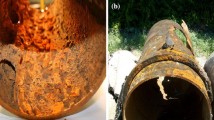Abstract
Generally, oil and gas pipeline is made of carbon steel, alloy steel and other metal materials. The biggest threat to the integrity of the oil and gas pipeline is the presence of corrosion. Corrosion will happened when the metal pipeline is affected by chemical or electrochemical attack, or microbial reaction with its environment. With the increasing of the service time, the corrosion of the oil and gas pipelines has become more and more serious. The wall thickness of the corroded pipeline will be lessened and that may lead the decrease of the strength of the pressurized pipeline. Thus, a leak may be happened at the corrosion area if the actual operation pressure of the pipeline is larger than the maximum safe pressure. So it is significant to study and assess the damage condition of the corroded oil and gas pipelines. Based on the theoretical foundations of fracture mechanics, the mathematical model for the failure pressure of corroded oil and gas pipelines was built in this paper firstly. And then, the corrosion damage level of the pipeline was divided into 3 grades according to the ability of the corroded pipeline. Furthermore, 20 corroded pipes were selected to study the damage assessment. The maximum safety operating pressure and damage level of each corroded pipe were carried out by applying the proposed mathematical model in the paper. As a result, the computational data were closed to the experimental data. The corrosion damage level and repair plan of the twenty pipes were discussed, and there were three pipes need to repair immediately. The results show that the proposed method can well assess the corrosion degree of the oil and gas pipelines with defects and can provide a scientific basis for the safe operation and emergency management of the oil and gas pipelines enterprise.
Access this chapter
Tax calculation will be finalised at checkout
Purchases are for personal use only
Similar content being viewed by others
References
Ma B, Shuai J, Liu DX, Xu K (2013) Assessment on failure pressure of high strength pipeline with corrosion defects. J Eng Fail Anal 32(1):209–219
Wu ZZ, Wang RJ (2014) Concern with the safety management of oil and gas pipelines–Status. Chin Saf News 6:1–5
He DS, Guo J, Zhang P (2007) Assessment method for remaining strength of corroded pipeline and its application. J Acta Petrolei Sinica 28(6):125–128
Shuai J, Xu K (2003) Assessment method for failure probability of corroded pipeline. J Acta Petrolei Sinica 24(4):86–89
Wang X, Zhao DF (2013) Safety assessment of oil gas pipelines corrosion based on ASME B31G standard. J Indus Saf Environ Prot 39(1):57–59
American society of mechanical engineers (2009). ASME B31G-2009. Manual for determining the remaining strength of corroded pipelines. American national standard:5–6
Huang J, Hou WW, Chen J (2013) Corrosion and protection of pipeline. J Liao Ning Chem Indus 11(1):1327–1330
Choi JB, Goo BK (2003) Development of limit load solutions for corroded gas pipelines. J Press Vessels Pip 80:121–128
Kiefner JF, Vieth PH (1989) A Modified criterion for evaluation the remaining strength of corroded pipe. Final report on project PR 3-805 to the pipeline research committee of the American Gas Association
Keith E (2006) Piping and pipelines assessment guide. Elsevier, Boston
Acknowledgements
The research work was supported by National science and technology Foundation of China under Grant No. 2015BAK16B01.
Author information
Authors and Affiliations
Corresponding author
Editor information
Editors and Affiliations
Rights and permissions
Copyright information
© 2016 Springer-Verlag Berlin Heidelberg
About this paper
Cite this paper
Wang, R., Tong, S. (2016). Research on Damage Assessment of Corroded Oil and Gas Pipelines Based on Fracture Mechanics. In: Huang, B., Yao, Y. (eds) Proceedings of the 5th International Conference on Electrical Engineering and Automatic Control. Lecture Notes in Electrical Engineering, vol 367. Springer, Berlin, Heidelberg. https://doi.org/10.1007/978-3-662-48768-6_84
Download citation
DOI: https://doi.org/10.1007/978-3-662-48768-6_84
Published:
Publisher Name: Springer, Berlin, Heidelberg
Print ISBN: 978-3-662-48766-2
Online ISBN: 978-3-662-48768-6
eBook Packages: EngineeringEngineering (R0)



